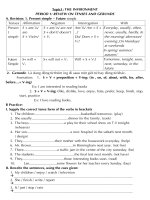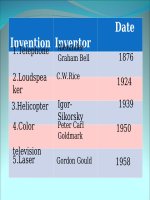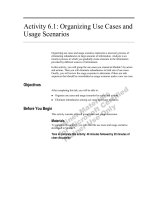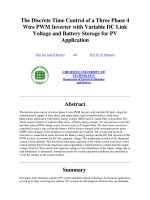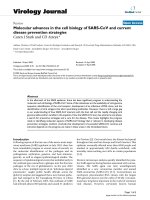Topic 1 sinusoidal alternating voltage and current topic a1
Bạn đang xem bản rút gọn của tài liệu. Xem và tải ngay bản đầy đủ của tài liệu tại đây (316.81 KB, 44 trang )
Solve Problems in Single and Three
Phase Low Voltage Circuits Part A
Content
Sinusoidal Alternating Voltage and Current
Phasor Representation of Voltage and
Current
Resistance in AC Circuits
Inductance in AC Circuits
Capacitance In AC Circuits
Analysis of AC Circuits
Resonance in AC Circuits
Nathan Condie
1
Solve problems in single and
three-phase low voltage circuits
Topic 1: Sinusoidal Alternating Voltage
and Current
Generation of a Voltage
Conductor
Magnetic Flux
Relative Motion
Nathan Condie
3
Induced Current or EMF in a Conductor
Current flowing AWAY from viewer
Current flowing TOWARD from viewer
Nathan Condie
4
Fleming’s Right-Hand Rule (for
generators)
Thumb – Indicates the direction of relative
motion or TRAVEL
First Finger – Indicates the direction of the
flow of magnetic FLUX
Centre Finger – indicates the direction of
induced CURRENT therefore induced EMF
Nathan Condie
5
Fleming’s Right-Hand Rule (for
generators)
Nathan CondieCopyright 2003 McGraw-Hill Australia Pty Ltd
PPTs t/a Electrical Principals
for theCondie
Electrical Trades 5e by Jenneson
Nathan
Slides prepared by Anne McLean
6
In each of the following examples, determine the direction of induced EMF
1.
2.
North
Conductor
Motion
S
N
South
4.
N
3.
N
S
Magnetic
Field
Nathan Condie
Motion
S
Magnetic
Field
Motion
7
Answers: Direction of induced EMF
1.
2.
North
Conductor
Motion
S
N
South
4.
N
3.
N
No Induced EMF –
travels parallel to flux
S
Magnetic
Field
Nathan Condie
Motion
S
Magnetic
Field
Motion
8
Further exercises using Fleming’s Right-Hand Rule (for Generators)
?
S
N
Direction of relative
motion of
conductor?
?
?
Polarity of magnetic
field poles?
?
N
Polarity of magnetic
field poles?
Nathan Condie
S
Direction of relative
motion of magnetic
field?
9
Answers: Fleming’s Right-Hand Rule (for Generators)
North
S
N
Direction of relative
motion of
conductor?
N
South
Polarity of magnetic
field poles?
S
N
Polarity of magnetic
field poles?
Nathan Condie
S
Direction of relative
motion of magnetic
field?
10
Fleming’s Right-Hand Rule (for Generators):
A single conductor formed into a loop
North
South
Front
View
Conductor Loop
Magnetic
Field
Poles
South
North
Nathan Condie
Top View
11
Generation of an AC Voltage
Copyright 2003 McGraw-Hill Australia Pty Ltd
PPTs t/a Electrical Principals
for theCondie
Electrical Trades 5e by Jenneson
Nathan
Slides prepared by Anne McLean
12
Generation of an AC Voltage
Voltage
1
2
3
4
5
N
N
N
N
N
S
S
S
S
S
Nathan Condie
Time
13
AC Waveform: Vertical Axis
The height the waveform reaches above (or below) the
horizontal axis represents its AMPLITUDE. Amplitude is
expressed as a:
Peak or Maximum Value
The distance from the zero value to the highest value on the curve
(either above or below the horizontal axis)
For a Voltage waveform, symbol VPk or VMax
For a Current waveform, symbol IPk or Imax
Peak-to-Peak Value
The distance between the top (crest) and bottom (trough) of the
waveform
For a Voltage waveform, symbol VP-P
For a Current waveform, symbol IP-P
VP-P=2VPk
Nathan Condie
14
AC Waveform: Vertical Axis
Instantaneous Value
The value at any point along the waveform
For Voltage waveform, symbol “v” (lowercase)
For Current waveform, symbol “i” (lowercase)
Sine Wave Only v = VmaxSinθ
Where
v is the instantaneous value of the sinewave at a specified point
Vmax is the maximum value of the sinewave
Sin is a function applied to the phase angle
Θ is the phase angle in degrees Electrical (indicates the rotation of loop)
Nathan Condie
15
AC Waveform: Vertical Axis
Average Value
A measure of the average energy available in an
AC waveform.
This value is only valid when the AC waveform is
RECTIFIED into DC (average for AC is zero).
Applicable mainly in electronics, and some
analogue meters.
Sine Wave Only
VAve = 0.637 Vmax
Nathan Condie
16
AC Waveform: Vertical Axis
RMS Value (Root-Mean-Square)
Represents the EFFECTIVE value of the AC waveform.
An RMS value represents the DC equivalent in terms of
electrical energy potential.
The RMS value of an alternating current (AC) waveform will
cause the same heat dissipation as that value of direct current
(DC).
Sine Wave Only
VRMS = 0.707 Vmax
ALL AC values given are considered to be RMS values, unless
otherwise specified
Nathan Condie
17
AC Waveform: Vertical Axis
Instantaneous values
Copyright 2003 McGraw-Hill Australia Pty Ltd
PPTs t/a Electrical Principals
for theCondie
Electrical Trades 5e by Jenneson
Nathan
Slides prepared by Anne McLean
18
AC Waveform: Horizontal Axis
Represents the Time Domain for an AC
waveform
Period, or Periodic Time
The time taken for the AC waveform to complete one full
cycle (360oE)
Symbol t, measured in Seconds (s)
Frequency
The number of cycles per second
Symbol ƒ, measured in Hertz (Hz)
ƒ = 1/t
Nathan Condie
19
AC Waveform: Horizontal Axis
one cycle
one cycle
Periodic Time
one cycle
Periodic time is measured between two EQUIVALENT points of the
waveform
Nathan Condie
20
AC Waveform: Electrical Degrees
Waveforms are only observed on
oscilloscopes where the horizontal axis is
normally given as a time base (in seconds)
rather than as an angle (in degrees).
To apply the instantaneous value formula,
any specified time value will need to be
converted to an angle (Electrical Degrees).
Nathan Condie
21
AC Waveform: Electrical Degrees
Conversion of Time to θ (theta) in Electrical
Degrees:
θ = tinstantaneous x 3600
tperiodic
Nathan Condie
22
AC Waveform: Exercises
Given a sinusoidal waveform with an RMS
value of 230V and a frequency of 50Hz,
calculate the instantaneous values of voltage
at the following points:
2mS
5mS
11mS
356mS
Nathan Condie
23
AC Waveform: Answers to Exercises
Step 1: Find VMax
Step 2: Find Periodic Time
(2mS) θ = 360E
Step 4: Calculate instantaneous voltage
t = 0.02 sec OR 20mS
Step 3: Convert instantaneous time to Electrical
Degrees
VMax = 325.3V
(2mS) v = +191.2V
Now repeat steps 3 and 4 for the other
instantaneous times.
Nathan Condie
24
AC Waveform: Answers to Exercises
Part 2
Part 3
(5mS) θ = 900E
(5mS) v = +325.3V
(11mS) θ = 1980E
(11mS) v = -100.5V
Part 4
(356mS) θ = 64080E
(356mS) v = -309.4V
Nathan Condie
25
